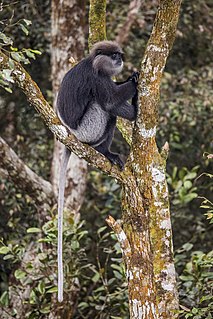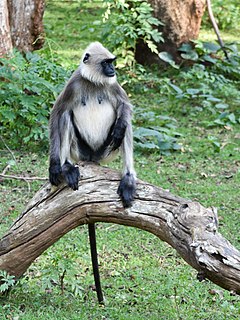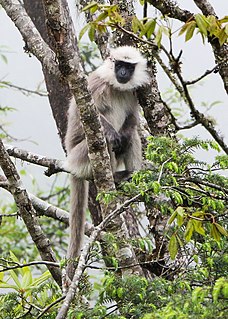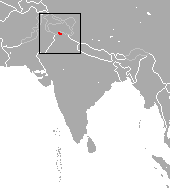
Gray langurs, also called Hanuman langurs and Hanuman monkeys, are Old World monkeys native to the Indian subcontinent constituting the genus Semnopithecus. Traditionally only one species Semnopithecus entellus was recognized, but since about 2001, additional species have been recognized. The taxonomy has been in flux, but currently eight species are recognized.

The purple-faced langur, also known as the purple-faced leaf monkey, is a species of Old World monkey that is endemic to Sri Lanka. The animal is a long-tailed arboreal species, identified by a mostly brown appearance, dark face and a very shy nature. The species was once highly prevalent, found in suburban Colombo and the "wet zone" villages, but rapid urbanization has led to a significant decrease in the population level of the monkeys. It had traditionally been classified within the lutung genus Trachypithecus but was moved to the genus Semnopithecus based on DNA evidence indicating that is it more closely related to the gray langurs.

The lutungs, langurs, or leaf monkeys are a group of Old World monkeys in the genus Trachypithecus. Their range is much of Southeast Asia.

The surilis are a group of Old World monkeys in the genus Presbytis. They live in the Thai-Malay Peninsula, on Sumatra, Borneo, Java and smaller nearby islands. Besides surili, the common names for the monkeys in the genus also sometimes use the terms "langur" or "leaf monkey."

The pig-tailed langur, monotypic in genus Simias, is a large Old World monkey, endemic to several small islands off the coast of Sumatra in Indonesia. Its face is black, its fur is blackish-brown and it has a relatively short tail. It is a diurnal species, feeding in small groups in the rainforest canopy on leaves, and to a lesser extent, fruit and berries. Little is known of its natural history, but it is heavily hunted, its populations have been declining rapidly and the International Union for Conservation of Nature has assessed its conservation status as being "critically endangered". It has been included on a list of the World's 25 Most Endangered Primates.

The Nilgiri langur is a langur. This primate has glossy black fur on its body and golden brown fur on its head. It is similar in size and long-tailed like the gray langurs. Females have a white patch of fur on the inner thigh. It typically lives in troops of nine to ten monkeys. Its diet consists of fruits, shoots and leaves. The species is classified as vulnerable due to habitat destruction and poaching for its fur and flesh, the latter believed to have aphrodisiac properties.

The black-footed gray langur is an Old World monkey, one of the species of langurs. Found in southern India, this, like other gray langurs, is a leaf-eating monkey.

The Hatinh langur is a highly threatened Old World monkey found in limestone forests in Vietnam, primarily in the Quảng Bình Province. A recent survey discovered a small population living in the Quảng Trị Province. Contrary to its name, it is not known from the Hà Tĩnh Province. The local Van Kieu minority refer to this lutung as the 'Con Cung', which roughly translates as "black, cliff-dwelling monkey with a long tail". It resembles the closely related François' langur, but its white cheek-stripes typically extend behind the ears onto the nape, and the overall black colour is non-glossy and has a brownish tinge.

The Cat Ba langur, also known as the golden-headed langur, is a critically endangered species of langur endemic to Cát Bà Island, Vietnam. It is among the rarest primates in the world, and possibly the rarest primate in Asia, with population size estimated at less than 70 individuals.

The Raffles' banded langur, also known as the banded leaf monkey or banded surili, is a species of primate in the family Cercopithecidae. It is endemic to Singapore and southern Peninsular Malaysia. The species underwent taxonomic revisions in 2019 and 2020, in which two former subspecies were elevated to separate species. As a result, the Raffles' banded langur meets the criteria for being listed as critically endangered by the IUCN. It is mainly threatened by habitat loss.

The Mentawai langur is a species of primate in the family Cercopithecidae. It is endemic to the Mentawai Islands in Indonesia. Its natural habitat is subtropical or tropical dry forests. The Siberut langur was formerly considered a subspecies of the Mentawai langur.

The northern plains gray langur, also known as the sacred langur, Bengal sacred langur and Hanuman langur, is a species of primate in the family Cercopithecidae.

The dusky leaf monkey, also known as the spectacled langur, or the spectacled leaf monkey is a species of primate in the family Cercopithecidae. It is found in Peninsular Malaysia, Myanmar and Thailand, and can occasionally be found in Singapore. During the day, these small, folivorous primates divide in sub-groups and forage for vegetation and fruit throughout the tropical forests. According to the IUCN, the dusky leaf monkey's population is declining due to habitat loss, poaching, and anthropogenic land use, which prompted the IUCN to classify the species as endangered in 2015.
The Indochinese black langur is a poorly known lutung native to Laos and adjacent Vietnam. It was originally described as a subspecies of T. auratus, but was later found to be a member of the T. francoisi group, with some maintaining it as a subspecies of that species. In 2001, it was recommended treating it as a separate species.

The Nepal gray langur is a gray langur endemic to the Himalayas in Nepal, far southwestern Tibet, northern India, northern Pakistan, Bhutan and possibly Afghanistan. It is found in forests at an elevation of 1,500 to 4,000 metres. Its easternmost limit in India is Buxa Tiger Reserve in northern West Bengal, at least up to the Rydak river.

The Kashmir gray langur is an Old World monkey, one of the langur species. It is a leaf-eating monkey.

The Tarai gray langur is an Old World monkey, and was formerly considered a subspecies of the northern plains gray langur. The species is listed as near threatened, as there are probably not many more than 10,000 mature individuals, and it is experiencing a continuing decline.

The tufted gray langur, also known as Madras gray langur, and Coromandel sacred langur, is an Old World monkey, one of the species of langurs. This, like other gray langurs, is mainly a leaf-eating monkey. It is found in southeast India and Sri Lanka. It is one of three Semnopithecus species named after characters from The Iliad, S. hector and S. ajax being the others. In Sinhala it is known as හැලි වදුරා.

The western purple-faced langur, also known as the north lowland wetzone purple-faced langur, is a subspecies of purple-faced langur endemic to Sri Lanka. It lives in the wet zone in western Sri Lanka around the former capital city of Colombo. This subspecies are known to live in tropical rainforest, specifically in an area of Sri Lanka, where it is noted to rain two times more compared to the neighboring region. The subspecies is generally gray-brown with lighter whiskers, a gray rump patch, and dark forearms and legs. These monkeys also have dark brown or black, hairless faces. Their hands and feet are also hairless. When infants, their fur is medium brown to light gray, however it changes to their darker adult colors at between 12 and 16 weeks old. Typical length is between 48 and 67 centimetres excluding tail, with a 59 to 85 centimetres tail. On average, males weigh 8.5 kilograms (19 lb) and females weigh 7.8 kilograms (17 lb). Their average life span is about 26 years if the monkey was held in captivity. Due to their leafy diet, the western purple-faced langur back teeth, include high crowns and pointed cusps to make eating through greenery simpler. They also developed a digestive system that would allow them to break down cellulose in the leaves they eat. Although, leaves are their primary source of food, they also eat fruits and flowers. Female langurs hold a pregnancy for 195-210 days, and after the birth the offsprings are taken closely cared for by the mother until they are about 12-20 weeks old.

The Selangor silvered langur is a species of leaf monkey found on the west coast of Peninsular Malaysia. It had been previously considered a form of silvery lutung. Roos and colleagues elevated this population to a subspecies level, Trachypithecus cristatus selangorensis, in 2008. It has since come to be regarded by primatologists as a separate species, Trachypithecus selangorensis.





















